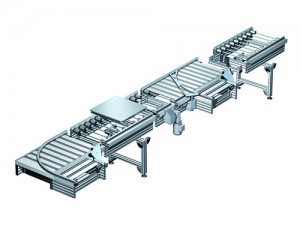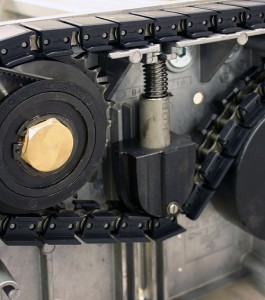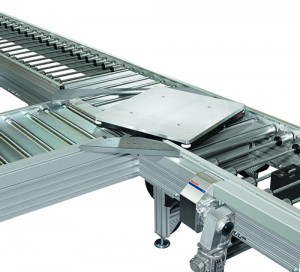
Conveyors make up a significant part of most assembly and automation systems, not only in size, but also in terms of energy consumption. Think about it – they often run continuously and operate with motors, gearboxes, and pneumatic cylinders, all of which can be energy hogs. But there are ways to reduce the amount of energy consumed by conveyors and reduce waste. We recently spoke with Mark Dinges, Product Manager – Factory Automation at Bosch Rexroth, about how users can save on operating costs for pallet conveyors by minimizing their energy use.
According to Dinges, if you want to optimize a conveyor’s energy consumption, you should look at more than just the individual components of the system.
Collins | Linear Motion Tips: What component or aspect of a pallet conveyor contributes the most to its energy consumption?
Dinges | Bosch Rexroth: It’s best to think of the conveyor as a complete system, because there are so many elements involved. Yes, it’s important to have energy-efficient motors and drive units, but if the conveyor chain or belt is not properly maintained, you may waste energy through additional friction in the system. Many conveyors use pneumatically-actuated stop gates, positioning units and other product-control accessories, so inefficiency can also occur if the pneumatic system is not properly maintained.
Bosch Rexroth has recently demonstrated how the use of sensors coupled with variable frequency drives can help save energy, by turning off power to individual sections of the conveyor system while no products are present there. But these savings are relatively small compared to the savings you can achieve through proper system and process design, including the pneumatics system.
Collins | Linear Motion Tips: What component or aspect of a pallet conveyor wastes the most energy, and what are the best strategies to avoid this wasted energy?
Dinges | Bosch Rexroth: In most power-and-free assembly conveyors, the belt or chain is continuously under power, but it is exactly this aspect of pallet-based conveyor systems that allows for work, i.e. pallets with mounted products, to be delivered to workstations as needed. This gives the best possible cycle time for product assembly, as long as the individual work processes are optimized at each station. You can optimize the energy use by selecting conveyors with low-friction curves or with drives that allow you to use fewer of them per given length of loaded conveyor. But the critical factor in minimizing waste is to optimize product throughput per hour.
In other words, if you have assembly workers standing around waiting for parts to arrive, or if your automated stations require a lot of downtime for maintenance, you will waste energy. So optimizing each assembly process through time and motion studies can make a significant impact on energy use.
In terms of components in the conveyor system, pneumatic systems are often the biggest culprits when it comes to wasted energy. As is true with manufacturing plants in general, pneumatic systems within conveyor assemblies can be inefficient or leaky, costing thousands of dollars annually in energy use that could be avoided. A thorough review of the pneumatic components and systems can lead to significant cost savings.
Collins | Linear Motion Tips: Pallet conveyors typically carry large loads. How does the weight of the load affect the conveyor’s energy use?
Dinges | Bosch Rexroth: Naturally, if you overload a section of the conveyor, or the system overall, you will waste energy. You’ll also cause additional wear and tear on the moving parts, including the belts or chains, pallet wear strips, as well as the gearbox and drive unit pulleys or sprockets. So overloading a conveyor is never a good idea, even if you don’t care about energy use.
The Rexroth pallet conveyors are designed to accommodate a wide range of loads, up to 300 kg per pallet with the new TS5 platform (including pallet weight and fixturing). Handling heavy loads like this requires a different approach than belts or chains, so the TS5 series is based on a powered-roller concept that controls the pallet momentum much more smoothly. Special curve designs minimize friction, and the low drive force requirements of the “king shaft” concept provide energy-efficient operation.
Collins | Linear Motion Tips: How does proper maintenance affect conveyor efficiency?
Dinges | Bosch Rexroth: This is an important point. Proper maintenance is often neglected with conveyor systems because they are simply expected to run and run. As long as everything works smoothly, no one thinks twice about them. But it is possible to keep a conveyor operating like new for years, at optimum efficiency. We recommend an annual or bi-annual tune-up or inspection, as do most conveyor suppliers. A quick, expert review of the system under operating conditions can identify wear parts that need replacing, opportunities for process optimization, and other potential hazards, such as overloading the system.
We also recommend a thorough review of the plant’s compressed air delivery systems, since substantial waste can occur here. Today’s pneumatics are also significantly more energy efficient, so the available savings may be greater than one might achieve by simply replacing leaky hoses.




Danielle, making sure your conveyor system is in good condition might be a good place to start. I’ve been told that skirting will prevent your conveyor from being damaged. More energy is probably used when your equipment isn’t in great condition or up to date.